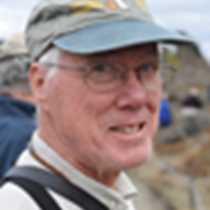Ideal Creek & Petersburg, Southeast Alaska
A tale of two habitats. Early morning found us approaching our morning anchorage at Ideal Creek, on Mitkoff Island. Our Zodiacs ran through a gauntlet of floats, each attached to a crab pot on the ocean bottom, attesting to the recent opening of the Dungeness crab season.
Ideal Creek offers a boardwalk trail through a magnificent Old Growth stand of the Temperate Rainforest. It is like a natural cathedral, with the richest of tapestries underfoot and tall columns leading to the canopy far above our head. The role of the organ was filled by the sound of the creek that runs next to the trail. The boardwalk offers us guilt-free entry into the forest, since we need not tread on the delicate vegetation.
Old Growth is not just any forest. It is the culmination of hundreds of years of forest succession. Individual trees come and go but the forest persists in a dynamic equilibrium. Seeds germinate to become seedlings. Some few survive to rise above the forest herbs and shrubs, and a tiny, fortunate fraction will grow into the giant trees of the forest canopy. When they die and fall to the forest floor they become the nurse logs that give birth to the next generation. As succession proceeds, slow-growing but shade tolerant Western hemlocks replace the Sitka spruce. A rich growth of moss seems to cover every available surface, and tiny herbaceous plants abound, offering a meal to passing Sitka black-tailed deer and moose. These herbivores have left their mark along the trail.
Once, Old Growth Temperate Rainforest extended, uninterrupted, from Central California to the Gulf of Alaska. In the southern part of this range most of it has been cut to satisfy our demand for lumber and for pulp. Old Growth forest remains only in isolated stands, protected in parks and preserves. Only in Alaska can we find large, contiguous stands of this resource, unimpacted by the hand of man and by his machinery to remind us of the world that we inherited. May it always be so.
Over lunch the National Geographic Sea Bird moved to the fishing town of Petersburg. There was more to do than time allowed, difficult decisions to be made. Some flew by float plane over the nearby Patterson Glacier, looking down on the flowing river of ice and spotting wildlife from the air. Some strolled along the docks to look at the diversity of Alaskan fishing vessels and engage colorful fishers in conversation. Rarely does an Alaskan fisher lack for an opinion, be it about fisheries management (generally positive) or sea otters and sperm whales depredating the resources upon which the fishers and their families depend (pretty strongly negative!).
Some chose to sample the shopping opportunities, including what is reputed to be Alaska’s best hardware store, supplying all that is needed to keep the boats at sea and their holds filled with fresh Alaskan seafood. And some of us crossed over to adjacent Kupreanof Island for a walk through the forest to a muskeg habitat. It offered a strong contrast to the Old Growth forest of our morning. Here the trees - mainly shore pines - are widely spaced and stunted, the defining characteristic of a muskeg. And here we found an array of plants that are quite different from those of the forest. Plants of the muskeg must be tolerant of saturated, acidic and nutrient-poor soils. The stars of the day were two species of sundews that capture insects on sticky glands and drain the prey of their nutrients.
Our day came full circle when the results of some of those crab pots, an abundance of fresh Dungeness crabs, found their way onto our dinner tables for our tasty, if messy, repast.




